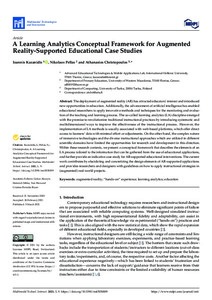A Learning Analytics Conceptual Framework for Augmented Reality-Supported Educational Case Studies
Pellas Nikolaos; Kazanidis Ioannis; Christopoulos Athanasios
A Learning Analytics Conceptual Framework for Augmented Reality-Supported Educational Case Studies
Pellas Nikolaos
Kazanidis Ioannis
Christopoulos Athanasios
MDPI
Julkaisun pysyvä osoite on:
https://urn.fi/URN:NBN:fi-fe2021093048564
https://urn.fi/URN:NBN:fi-fe2021093048564
Tiivistelmä
The deployment of augmented reality (AR) has attracted educators' interest and introduced new opportunities in education. Additionally, the advancement of artificial intelligence has enabled educational researchers to apply innovative methods and techniques for the monitoring and evaluation of the teaching and learning process. The so-called learning analytics (LA) discipline emerged with the promise to revolutionize traditional instructional practices by introducing systematic and multidimensional ways to improve the effectiveness of the instructional process. However, the implementation of LA methods is usually associated with web-based platforms, which offer direct access to learners' data with minimal effort or adjustments. On the other hand, the complex nature of immersive technologies and the diverse instructional approaches which are utilized in different scientific domains have limited the opportunities for research and development in this direction. Within these research contexts, we present a conceptual framework that describes the elements of an LA process tailored to the information that can be gathered from the use of educational applications, and further provide an indicative case study for AR-supported educational interventions. The current work contributes by elucidating and concretizing the design elements of AR-supported applications and provides researchers and designers with guidelines on how to apply instructional strategies in (augmented) real-world projects.
Kokoelmat
- Rinnakkaistallenteet [19207]
